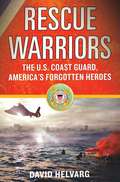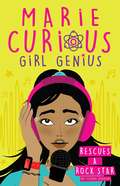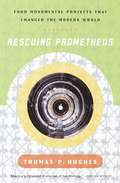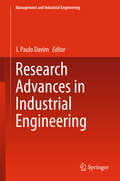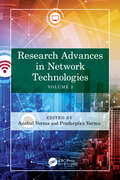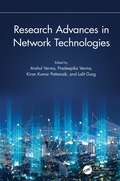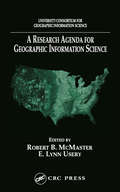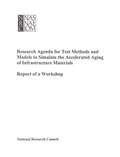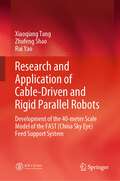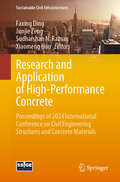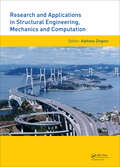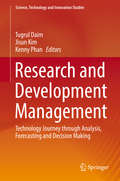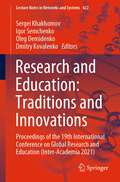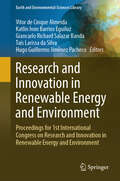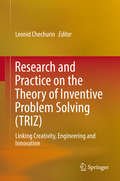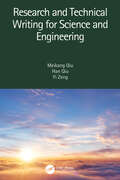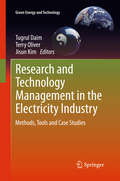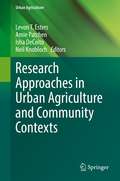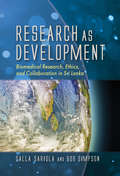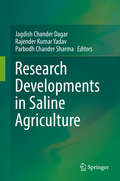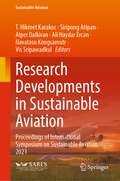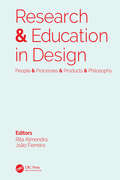- Table View
- List View
The Rescue Mission (Tom Swift, #6)
by Victor AppletonTom and his friends find themselves in the hands of unfriendly robots who are trying to eliminate all biological life from their planet.
Rescue Warriors: The U. S. Coast Guard, America's Forgotten Heroes
by David HelvargHelvarg brings us into the daily lives of Coasties, filled with excitement, adrenaline, and dozens of death-defying rescues at sea and on land. Helvarg spent two years with the men and women of the Coast Guard, from the halls of the Coast Guard Academy in New London, Connecticut, to then frigid, storm-tossed waters of Alaska's Bering Sea, to the North Arabian Gulf, where they currently guard Iraqi oil terminals.
Rescues a Rock Star: Book 2 (Marie Curious, Girl Genius #2)
by Chris Edison50% Girl + 50% Genius = 100% Awesome! A brilliant new series with a heroine who uses her smarts - and her girl squad - to save the world from evil, one invention at a time. Marie is reunited with her geek girl friends when Sterling Vance invites them to present their winning invention at a big tech fair in London. There, the four young female scientists befriend a young pop star, whose tour Vance is sponsoring. She's unhappy with the way her management is making her try to be someone she's not. When the pop star disappears on the eve of her high-tech world tour, it's up to Marie and her friends to track her down so the show can go on.
Rescuing Prometheus: Four Monumental Projects that Changed Our World
by Thomas P. Hughes"A rare insight into industrial planning on a huge scale...Excellent." --The EconomistRescuing Prometheus is an eye-opening and marvelously informative look at some of the technological projects that helped shape the modern world. Thomas P. Hughes focuses on four postwar projects whose vastness and complexity inspired new technology, new organizations, and new management styles. The first use of computers to run systems was developed for the SAGE air defense project. The Atlas missile project was so complicated it required the development of systems engineering in order to complete it. The Boston Central Artery/Tunnel Project tested systems engineering in the complex crucible of a large scale civilian roadway. And finally, the origins of the Internet fostered the collegial management style that later would take over Silicon Valley and define the modern computer industry. With keen insight, Hughes tells these fascinating stories while providing a riveting history of modern technology and the management systems that made it possible.From the Trade Paperback edition.
Research Advances in Industrial Engineering
by J. Paulo DavimThis book provides discussions and the exchange of information on principles, strategies, models, techniques, methodologies and applications of industrial engineering. It communicates the latest developments and research activity on industrial engineering and is useful for all those interested in the technological challenges in the field.
Research Advances in Network Technologies: Volume 2
by Anshul Verma Pradeepika VermaIn the present technological age, information is a valuable resource for both small and large enterprises as well as for our daily lives. The key enablers that link computer resources and devices together to gather, process, and distribute crucial data both locally and worldwide are network technologies. For our daily lives and commercial operations, network technologies offer effective, adaptable, and seamless communication while maximizing productivity and resources.Due to its significance, this field has undergone a significant evolution in the past few decades, moving away from traditional wired networks and toward Bluetooth, infrared, microwave, radio, and satellite networks. These days, network technologies are not employed only in computer labs, businesses, or homes; a wide range of domains, such as vehicular ad hoc networks, mobile ad hoc networks, and the Internet of Things, have been seen using network technologies.Researchers from academia and industry have worked hard to build and develop software-based network technologies, such as middleware, protocol stacks, and network software architectures, in addition to hardware-based and physical network technologies. The paradigm shift in this field is being driven primarily by software-based network technologies, which have also given rise to numerous new network innovations, including grid computing, cloud computing, fog computing, edge computing, software-defined networks, and content-centric networks. Significant efforts have been made in cellular network technologies to boost the user experience, and as a result, new cellular network technologies, including LTE, VoLTE, and 5G, have also been developed.Efforts continue to be made by researchers in these networking fields due to the demand for and importance of these technologies in present and future situations. Many of these efforts are still in progress, and there are still possibilities that need to be investigated. As a result, it’s important to stay up to date on network technology developments and look into further research difficulties that need to be resolved for the benefit of users. This book will present the most recent and leading research in the field of network technologies in order to achieve solutions for various problems that exist in this domain.
Research Advances in Network Technologies
by Anshul Verma Pradeepika Verma Kiran Kumar Pattanaik Lalit GargIn current digital era, information is an important asset for our daily life as well as for small and large-scale businesses. The network technologies are the main enablers that connect the computing devices and resources together to collect, process and share vital information locally as well as globally. The network technologies provide efficient, flexible and seamless communication while maximizing productivity and resources for our day-to-day lives and business operations. For all its importance, this domain has evolved drastically, from the traditional wired networks to Bluetooth, infrared-waves, micro-waves, radio-waves and satellite networks. Nowadays, network technologies are not only restricted to computer laboratories, offices or homes; many other diverse areas have been witnessed where network technologies are being used based on the applications and needs, such as vehicular ad-hoc networks, underwater networks, and the Internet of Things. Along with the hardware-based and physical network technologies, a lot of research has been carried out by researchers from academia and industry to develop emerging software-based network technologies, such as network software architectures, middleware, and protocol stacks. The software-based network technologies become the main driving force behind the paradigm shift in this domain and have invented many new network technologies such as grid computing, cloud computing, fog computing, edge computing, software defined networks, content centric networks and so on. On the other hand, a lot of efforts have been made in cellular network technologies to improve the user experience and as a consequence, emerging cellular network technologies like LTE, VoLTE and 5G have been invented. Due to its demand and importance in present and future scenarios, numerous efforts have been done in the networking domain by the researchers, a lot of work is still ongoing, and many more possibilities have yet to be explored. Therefore, there is a need to keep track of advancements related to the network technologies and further investigate several ongoing research challenges for the ease of users. With this goal in mind, Research Advances in Network Technologies presents the most recent and notable research on network technologies.
A Research Agenda for Geographic Information Science
by E. Lynn Usery Robert B. McMasterA close relationship exists between GIS and numerous applications, including cartography, photogrammetry, geodesy, surveying, computer and information science, and statistics, among others. Scientists coined the term "geographic information science (GIScience)" to describe the theory behind these fields. A Research Agenda for Geographic Information
Research Agenda for Test Methods and Models to Simulate the Accelerated Aging of Infrastructure Materials: Report of a Workshop
by Board On Infrastructure the Constructed EnvironmentThe National Academies Press (NAP)--publisher for the National Academies--publishes more than 200 books a year offering the most authoritative views, definitive information, and groundbreaking recommendations on a wide range of topics in science, engineering, and health. Our books are unique in that they are authored by the nation's leading experts in every scientific field.
Research and Application of Cable-Driven and Rigid Parallel Robots: Development of the 40-meter Scale Model of the FAST (China Sky Eye) Feed Support System
by Xiaoqiang Tang Zhufeng Shao Rui YaoThis book is the first academic monograph on the Five-Hundred-Meter Aperture Spherical Radio Telescope (FAST, or China’s ‘sky eye’), which discusses the research on cable-driven and rigid parallel robots in detail. Taking the final scale model of the FAST feed support system as the object, it introduces the theoretical and engineering research on optimal design, accuracy improvement, and control of the cable-driven and rigid parallel robots, striving to clearly illustrate the core technology of the FAST feed support system, as well as the theoretical methodology and engineering technology of cable-driven and rigid parallel mechanisms. The theoretical innovation and technological breakthroughs of the cable-driven and rigid parallel robots directly support the implementation of the feed support system, which is one of the three major innovations of the FAST. This book is geared toward the high-performance development trend of robotics and follows the complete development process of the design, control, and engineering practice of the FAST feed support system. It systematically elaborates the core theories and technologies, such as dynamic modeling, precision analysis, dimension synthesis, vibration suppression control, and inertia matching of cable-driven and rigid parallel robots. This book elaborates on theoretical research and engineering practice, which have significant inspiration and reference effects. It guides readers to gain engineering experience and practical knowledge. The intended readership includes researchers, postgraduate students, undergraduate students, technology enthusiasts, etc.
Research and Application of High-Performance Concrete: Proceedings of 2024 International Conference on Civil Engineering Structures and Concrete Materials (Sustainable Civil Infrastructures)
by Faxing Ding Junjie Zeng Sudharshan N. Raman Xiaomeng HouThis book collects research outcomes related to high-performance concrete as a civil engineering material, providing readers with targeted research experiences and case analyses. From the introduction of Portland cement in the 1920s to the emergence of the water-cement ratio theory in the early 20th century, concrete has become a robust foundation for the rapid development of modern architecture. Due to its advantages and performance superior to traditional natural materials, it has become the primary building material for modern structures. As building heights and design requirements have increased, ordinary concrete can no longer meet modern architectural needs, making high-performance concrete a necessity for engineering projects. Currently, high-performance concrete is primarily produced by altering the water-cement ratio and adding admixtures. With the gradual scarcity of natural aggregates, high-performance concrete can meet safe design standards while reducing resource consumption. Compared to ultra-high-performance concrete, high-performance concrete is currently more suitable for engineering applications and has a more mature and comprehensive production process and applicability.This book includes selected papers from 2024 International Conference on Civil Engineering Structures and Concrete Materials, focusing on the mechanism studies and applications of high-performance concrete. We hope to share the latest research on high-performance concrete with civil engineering materials engineers worldwide, especially studies on fiber-reinforced concrete and high-performance concrete for complex application environments.
Research and Applications in Structural Engineering, Mechanics and Computation
by Alphose ZingoniResearch and Applications in Structural Engineering, Mechanics and Computation contains the Proceedings of the Fifth International Conference on Structural Engineering, Mechanics and Computation (SEMC 2013, Cape Town, South Africa, 2-4 September 2013). Over 420 papers are featured. Many topics are covered, but the contributions may be seen to fall
Research and Development Management
by Tugrul Daim Jisun Kim Kenny PhanThis book introduces readers to essential technology assessment and forecasting tools, demonstrating their use on the basis of multiple cases. As organizations in the high-tech industry need to be able to assess emerging technologies, the book presents cases in which formal decision-making models are developed, providing a framework for decision-making in the context of technology acquisition and development. Applications of different technology forecasting tools are also discussed for a range of technologies and sectors, providing a guide to keep R&D organizations abreast of technological trends that affect their business. As such, the book offers a valuable the theoretical and practical reference guide for R&D managers responsible for emerging and future technologies.
Research and Development of Deck Bridges (SpringerBriefs in Applied Sciences and Technology)
by Vincent Kvočák Daniel DubeckýThis book focuses on deck bridges with encased steel beams. The chapters discuss the design process in deck bridges in the past and some current issues regarding the design and construction of this type of bridges, particularly in Slovakia. The theoretical part covers the latest achievements of international endeavours in composite bridge research. The authors provide results on research into structures with encased steel beams, based on experiments carried out solely by the Department of Structural Engineering of the Faculty of Civil Engineering at the Technical University in Kosice. The results obtained are compared with numerical simulations and analytical calculations. The book also contains some information on testing the materials of steel and concrete and their characteristics. Finally, a variety of types of composite action between steel and concrete have been examined and are discussed.
Research and Education: Proceedings of the 19th International Conference on Global Research and Education (Inter-Academia 2021) (Lecture Notes in Networks and Systems #422)
by Sergei Khakhomov Igor Semchenko Oleg Demidenko Dmitry KovalenkoThis book contains selected articles presented at the 19th International Conference on Global Research and Education, organized by the Francisk Skorina Gomel State University in Gomel, Belarus, Octoter 20–22, 2021. The areas of focus of the book are modern areas of physics and technology, as well as methods and materials of e-learning and online education. It covers areas as plasma physics, bioengineering, solid state physics, nanoelectronics, photonics, environmental design, compositional structures and metamaterials, robotics and metrology, computer physics, online education and e-learning.
Research and Innovation in Renewable Energy and Environment: Proceedings for 1st International Congress on Research and Innovation in Renewable Energy and Environment (Earth and Environmental Sciences Library)
by Vitor de Cinque Almeida Katlin Ivon Barrios Eguiluz Giancarlo Richard Salazar Banda Taís Larissa da Silva Hugo Guillermo Jiménez PachecoRenewable energies reduce dependence on fossil fuels and minimize the carbon footprint. Solar panels and wind turbines decrease emissions and costs in the industry. Socially, they benefit disconnected communities, improving quality of life and providing opportunities. Sustainable development seeks equity and social inclusion, driving sustainable energy solutions. Renewable energies promote a prosperous and equitable future, addressing environmental and economic challenges. The energy transition is everyone's responsibility to ensure a greener and brighter tomorrow. On the other hand, environmental biotechnology and marine biology are fundamental to address environmental challenges. Research on treating effluents from the dairy, textile, and mining sectors seeks solutions to reduce water pollution. Industrial waste valorization through biotechnology aims to decrease pollution and resource depletion. The production of bio-products, biomaterials, bioplastics, and biofuels offerssustainable alternatives with a lower carbon footprint. Marine biology focuses on understanding and conserving aquatic ecosystems in the face of climate change and human influence. Biotechnology also contributes to the sustainable use of national biodiversity, with applications in pharmaceutical, cosmetic, and agricultural industries. These multidisciplinary fields are advancing towards a more sustainable and environmentally friendly future. The conference proceedings will consist of original research articles, reviews, and short communications covering several types of renewable energies: Solar including photovoltaic cells or solar thermal systems, Wind, Hydropower, Biomass-based energy, Geothermal, Waves Energy, Hydrogen, Bioenergy, or energy from biological processes, and fuel cell systems. In addition, studies focused on Environmental Biotechnology, including Bioremediation, Bioenergy Production, Microbial Fuel Cells, Waste Valorization, Microplastic Biodegradation, Biodegradable Materials and Phytoremediation, as well as focused on Marine Biology, including Marine Biodiversity and Conservation, Marine Genomics, Ocean Acidification, Marine Ecotoxicology, and Marine Biotechnology and Microbiology. Other environmental areas of research can be also included such as industrial wastewater systems or the development of sustainable solutions for a healthier and more resilient environment.
Research and Practice on the Theory of Inventive Problem Solving (TRIZ)
by Leonid ChechurinThis book clarifies the common misconception that there are no systematic instruments to support ideation, heuristics and creativity. Using a collection of articles from professionals practicing the Theory of Inventive Problem Solving (TRIZ), this book presents an overview of current trends and enhancements within TRIZ in an international context, and shows its different roles in enhancing creativity for innovation in research and practice. Since its first introduction by Genrikh Saulovich Altshuller in 1956 in the USSR, the TRIZ method has been widely used by inventors, design engineers and has become a standard element of innovation support tools in many Fortune 500 companies. However, TRIZ has only recently entered the domain of scientific publications and discussion. This collection of articles is meant as a record of scientific discussion on TRIZ that reflects the most interesting talking points, research interests, results and expectations. Topics such as Creative and Inventive Design, Patent Mining, and Knowledge Harvesting are also covered in this book.
Research and Technical Writing for Science and Engineering
by Yi Zeng Meikang Qiu Han QiuEngineering and science research can be difficult for beginners because scientific research is fraught with constraints and disciplines. Research and Technical Writing for Science and Engineering breakdowns the entire process of conducting engineering and scientific research. This book covers those fascinating guidelines and topics on conducting research, as well as how to better interact with your advisor. Key Features: advice on conducting a literature review, conducting experiments, and writing a good paper summarizing your findings. provides a tutorial on how to increase the impact of research and how to manage research resources. By reflecting on the cases discussed in this book, readers will be able to identify specific situations or dilemmas in their own lives, as the authors provide comprehensive suggestions based on their own experiences.
Research and Technology Management in the Electricity Industry: Methods, Tools and Case Studies
by Terry Oliver Jisun Kim Tugrul DaimTechnologies such as renewable energy alternatives including wind, solar and biomass, storage technologies and electric engines are creating a different landscape for the electricity industry. Using sources and ideas from technologies such as renewable energy alternatives, Research and Technology Management in the Electricity Industry explores a different landscape for this industry and applies it to the electric industry supported by real industry cases. Divided into three sections, Research and Technology Management in the Electricity Industry introduces a range of methods and tools including technology assessment, forecasting, roadmapping, research and development portfolio management and technology transfer. These tools are the applied to emerging technologies in this industry with case studies including data from various organizations including Bonneville Power Administration and Energy Trust of Oregon, from sectors including lighting and wind energy. The final section considers innovation through these technologies. A product result of a collaboration between Bonneville Power Administration and Portland State University, Research and Technology Management in the Electricity Industry is a comprehensive collection of methods, tools, examples and pathways for future innovation in the electricity industry.
Research Approaches in Urban Agriculture and Community Contexts (Urban Agriculture)
by Levon T. Esters Amie Patchen Isha DeCoito Neil KnoblochThis book will fill a void in the literature around research and program design and the impact of such experiences on learning outcomes within urban agricultural contexts. In particular, this book will cover topics such as STEM integration, science learning, student engagement, learning gardens and curriculum design.
Research as Development: Biomedical Research, Ethics, and Collaboration in Sri Lanka
by Salla Sariola Robert SimpsonIn Research as Development, Salla Sariola and Bob Simpson show how international collaboration operates in a setting that is typically portrayed as "resource-poor" and "scientifically lagging." Based on their long-term fieldwork in Sri Lanka, Sariola and Simpson bring into clear ethnographic focus the ways international scientific collaborations feature prominently in the pursuit of global health in which research operates "as" development and not merely "for" it. The authors follow the design, inception, and practice of two clinical trials: one a global health charity funded trial and the other a pharmaceutical industry-sponsored trial. Research as Development situates these two trials within their historical, political and cultural contexts and thus counters the idea that local actors are merely passive recipients of new technical and scientific rationalities. While social studies of clinical trials are beginning to be an established niche in academic writing, Research as Development helps fill important gaps in the literature through its examination of clinical research situated in cultures in low-income settings. Research as Development is noteworthy for the way it highlights the critical and creative role that local researchers play in establishing international collaborations and making them work into locally viable forms. The volume shows how these clinical and research interactions bring about changes in culture, technologies and expertise in Sri Lanka, contexts that have not previously been written about in any detail.
Research Developments in Saline Agriculture
by Jagdish Chander Dagar Rajender Kumar Yadav Parbodh Chander SharmaSoil and water salinity is a major challenge for the agricultural community and policy makers in terms of meeting the burgeoning population’s demand for food and other agricultural commodities. In coastal regions, climate change and sea level rise will aggravate the problem with more and more areas becoming saline due to intrusion of sea water. As such there is a pressing need for modern tools and innovative techniques for the identification of salty soils and poor-quality waters, crop production, soil reclamation and lowering the water table in waterlogged areas. Tackling next-generation problems such as contamination of soil and underground water due to fluoride and arsenic, as well as developing multi-stress tolerant crops is also a high priority. Further, techniques for domesticating halophytes, mangrove-based aquacultures, using seaweed cultures as agricultural crops and integrated farming systems need to be perfected. This book addresses all these aspects in detail, highlighting the diverse solutions to tackle the complex problem of salinity and waterlogging and safer management of poor-quality waters. With chapters written by leading experts, it is a valuable resource for researchers planning future investigations, policy makers, farmers and other stakeholders, and for students wanting insights into vital issues of environment.
Research Developments in Sustainable Aviation: Proceedings of International Symposium on Sustainable Aviation 2021 (Sustainable Aviation)
by T. Hikmet Karakoc Siripong Atipan Alper Dalkiran Ali Haydar Ercan Navatasn Kongsamutr Vis SripawadkulSustainable aviation is a long-term strategy aimed at providing innovative solutions to the challenges facing the aviation industry. The International Symposium on Sustainable Aviation is a multi-disciplinary symposium that presents research on current sustainability-based issues and future trends in the field of aviation from an economic, social, and environmental perspective. The conference provides a platform offering insights on a broad range of current issues in aviation, such as improving aircraft fuel efficiency, fostering the use of biofuels, minimizing environmental impact, mitigating GHG emissions, and reducing engine and airframe noise. ISSA allows researchers, scientists, engineers, practitioners, policymakers, and students to exchange information, present new technologies and developments, and discuss future direction, strategies, and priorities in aviation and sustainability.
Research & Education in Design: Proceedings of the 1st International Conference on Research and Education in Design (REDES 2019), November 14-15, 2019, Lisbon, Portugal
by Rita AlmendraDesign is about the creation of meaningful connections to solve problems and advance human wellbeing; the discipline has always explored the beneficial links between form and function, technology and meaning, beauty and utility, people and artefacts and problems and solutions, among others. This book focuses on the crucial connection between design research and design education. Contemporary society grows increasingly hyper-complex and globally competitive. This state of affairs raises fundamental questions for both Design Education and Design Research: Should research skills be integrated into undergraduate courses? How can we modify design courses without compromising the positive aspects of the educational studio experience? Can the three cycles of higher education in design be combined into a creative and inquisitive educational continuum? To examine the relationship between research and education in Design we must address the topic of knowledge, keeping in mind that the development and dissemination of new and useful knowledge is the core purpose of a University. If we agree that design has its own things to know and ways to find out about them, then design knowledge resides in people, processes, products, and philosophy. This book explores the intersection of these four areas with the aim of uncovering insights to advance the current state of the design discipline.
Research Ethics:
by Gary ComstockEducation in the responsible conduct of research typically takes the form of online instructions about rules, regulations, and policies. Research Ethics takes a novel approach and emphasizes the art of philosophical decision-making. Part A introduces egoism and explains that it is in the individuals own interest to avoid misconduct, fabrication of data, plagiarism and bias. Part B explains contractualism and covers issues of authorship, peer review and responsible use of statistics. Part C introduces moral rights as the basis of informed consent, the use of humans in research, mentoring, intellectual property and conflicts of interests. Part D uses two-level utilitarianism to explore the possibilities and limits of the experimental use of animals, duties to the environment and future generations, and the social responsibilities of researchers. This book represents a fresh approach to research ethics. It will engage the moral imaginations of graduate students in all disciplines.

